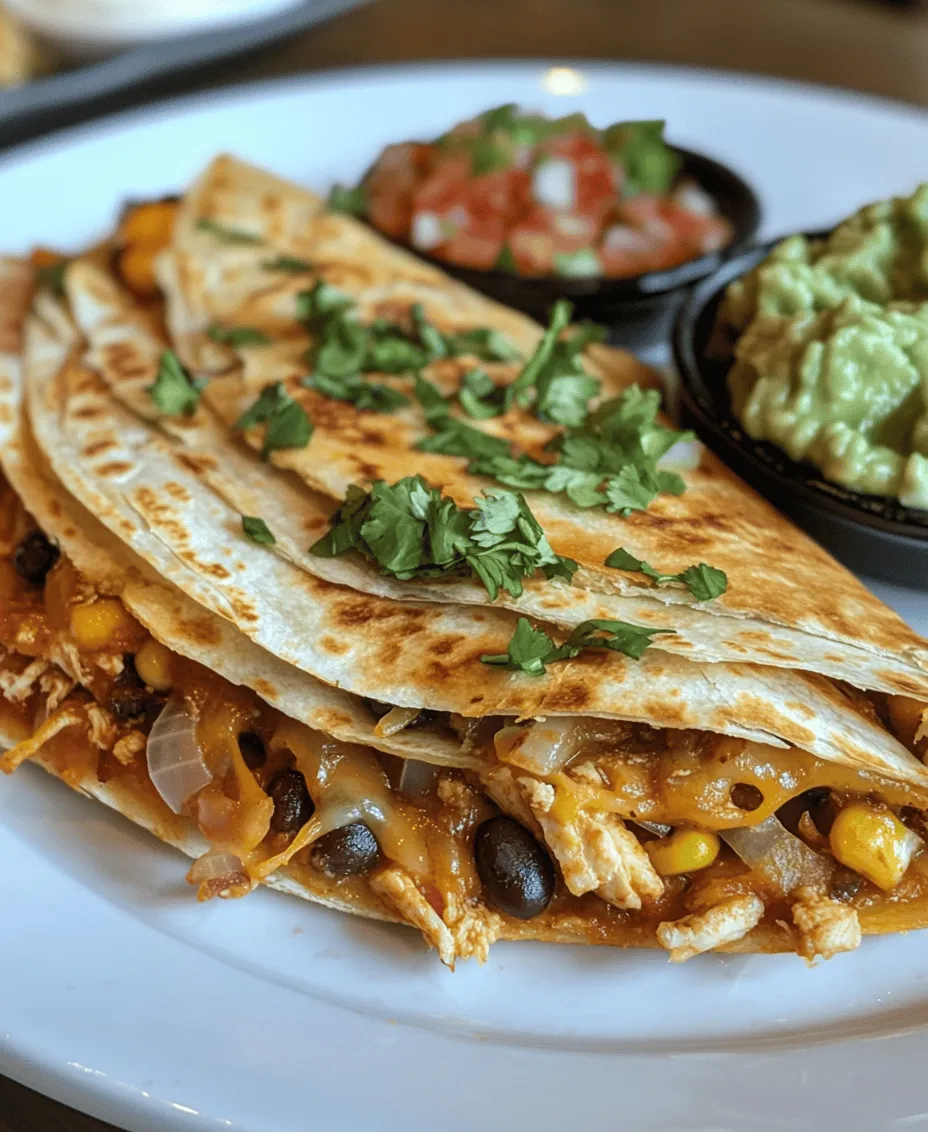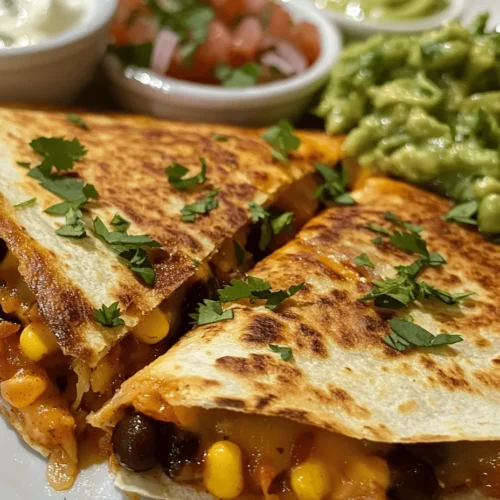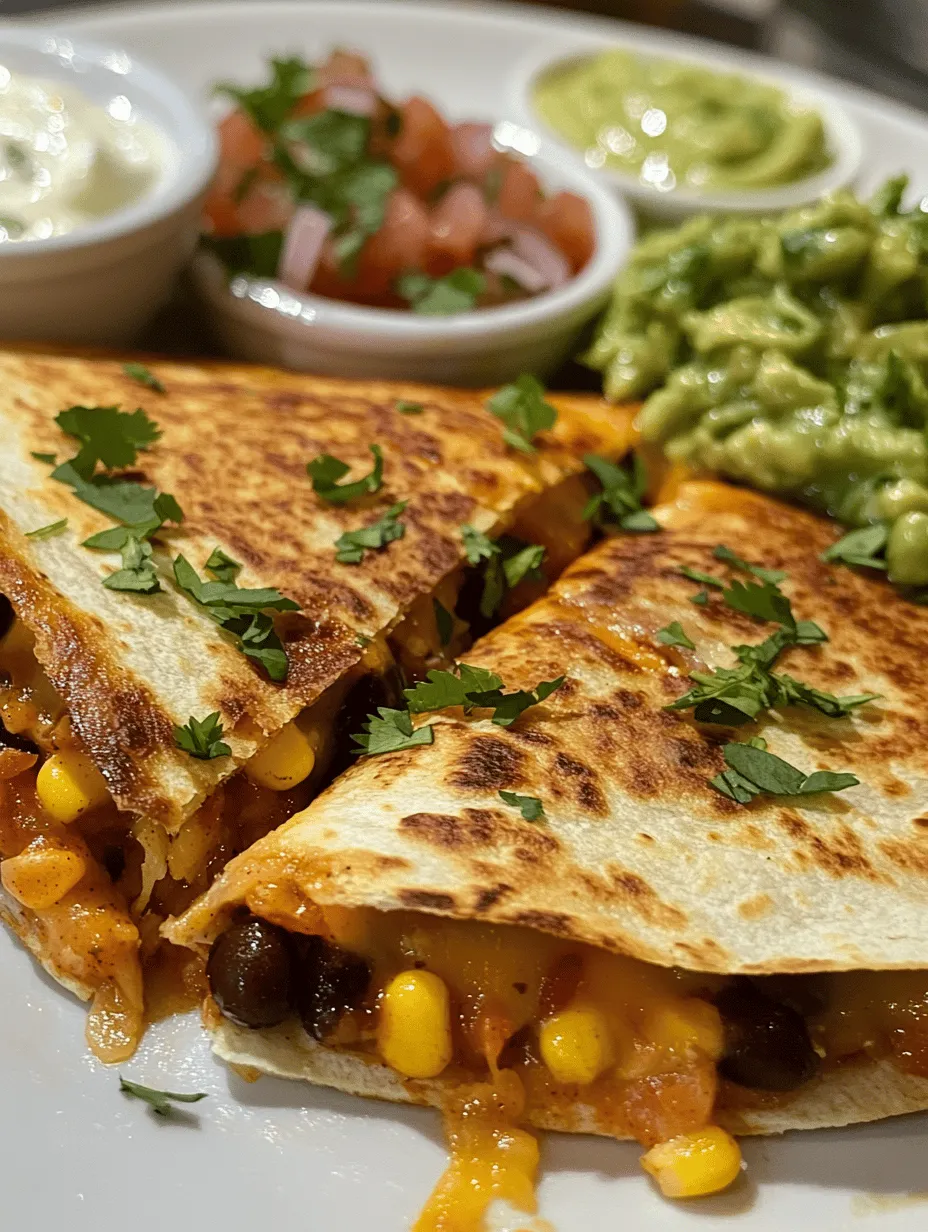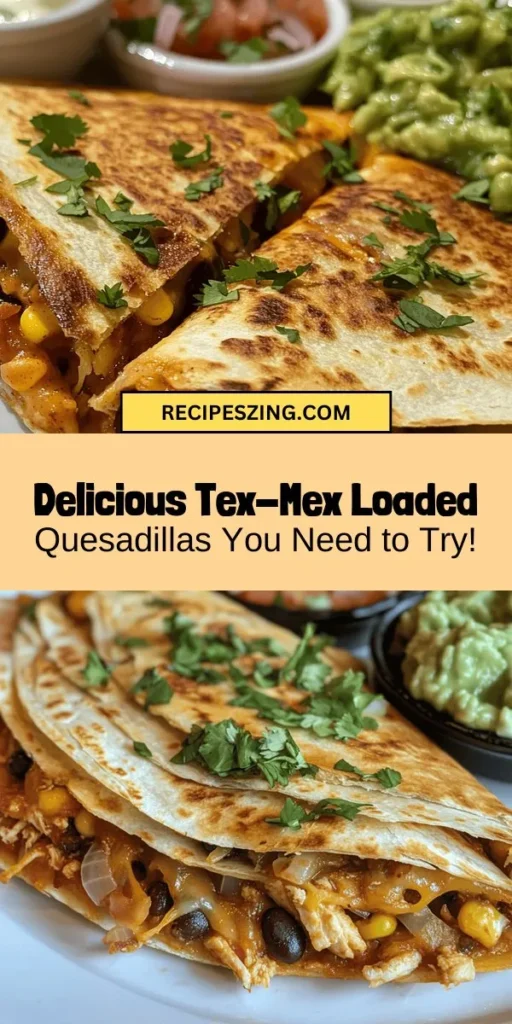Introduction
Tex-Mex cuisine has carved out a beloved niche in the culinary world, celebrated for its bold flavors and hearty dishes. This fusion of Texan and Mexican influences offers a delightful array of options that can satisfy even the most discerning palate. Among the numerous dishes that exemplify this vibrant cuisine, loaded quesadillas stand out as a particularly appealing choice. Not only do they deliver a satisfying meal option, but they also provide endless possibilities for customization, making them a favorite among families and food enthusiasts alike.
What makes loaded quesadillas truly special is their versatility. Whether you’re a meat lover, a vegetarian, or following a vegan diet, quesadillas can be tailored to suit any dietary need. The base of melted cheese and warm tortillas serves as a canvas for a variety of fillings—ranging from savory proteins to fresh vegetables and rich spices. This adaptability not only allows for creative expression in the kitchen but also ensures that everyone at the table can enjoy a delicious meal crafted to their preferences.
Understanding Tex-Mex Cuisine
Definition and History of Tex-Mex Cuisine
Tex-Mex cuisine is a culinary style that originated in Texas, blending traditional Mexican cooking with elements from American culture, particularly the southwestern United States. The term “Tex-Mex” first emerged in the late 19th century, reflecting the fusion of Texan and Mexican flavors, techniques, and ingredients. It encompasses a range of dishes, from tacos and enchiladas to nachos and, of course, quesadillas.
The roots of Tex-Mex can be traced back to the early settlers of Texas, where Mexican immigrants began adapting their traditional recipes to incorporate local ingredients and flavors. Over the years, Tex-Mex has evolved into a distinct cuisine, characterized by its use of ingredients like cheddar cheese, ground beef, and flour tortillas, which are less common in traditional Mexican cooking.
Key Ingredients Commonly Found in Tex-Mex Dishes
Certain ingredients are staples in Tex-Mex cuisine, contributing to its unique flavor profile. These include:
– Cheese: Cheddar and Monterey Jack are the most commonly used cheeses, known for their meltability and rich flavors.
– Proteins: Ground beef, chicken, and pork are popular choices, but seafood and plant-based options have gained traction in recent years.
– Beans: Black beans and pinto beans add protein and texture to many dishes.
– Vegetables: Fresh produce, such as onions, bell peppers, and tomatoes, enhance flavor and nutrition.
– Spices: Cumin, chili powder, and garlic powder are essential for achieving the characteristic Tex-Mex taste.
Cultural Significance and Popularity of Quesadillas
Quesadillas hold a special place in Tex-Mex cuisine. They are not only delicious but also represent a practical and adaptable meal option. Traditionally made with just cheese and tortillas, quesadillas have evolved to include a wide range of fillings, transforming them into a loaded delight that appeals to all ages. Their ease of preparation makes quesadillas a go-to choice for busy weeknight dinners or casual gatherings with friends and family.
As Tex-Mex cuisine continues to gain popularity around the world, quesadillas have become a beloved dish that transcends cultural boundaries. With their crispy exteriors and gooey interiors, loaded quesadillas are sure to be a hit whether served at a festive gathering or enjoyed as a comforting meal at home.
Ingredients Breakdown
Creating the perfect loaded quesadilla starts with selecting high-quality ingredients. Here’s a detailed breakdown of the primary components that will elevate your quesadillas from ordinary to extraordinary:
Flour Tortillas: Types and Qualities to Look For
The foundation of any quesadilla is the tortilla. For loaded quesadillas, flour tortillas are typically preferred due to their flexibility and ability to hold the filling without tearing. When choosing tortillas, consider the following:
– Size: Opt for larger tortillas (10-12 inches) for generous fillings and easy folding.
– Freshness: Look for tortillas made with simple ingredients and minimal preservatives. Fresh or homemade tortillas will provide the best texture and flavor.
– Thickness: Thicker tortillas can stand up to heavier fillings, while thinner varieties may be more suitable for lighter options.
Cheddar and Monterey Jack Cheese: Flavor Profiles and Melting Properties
Cheese is a key player in loaded quesadillas, providing that irresistible gooeyness. Using a combination of cheeses can enhance the flavor and texture of the finished dish:
– Cheddar Cheese: A sharp cheddar adds a robust flavor that pairs well with spicy fillings. It melts beautifully, creating a creamy texture.
– Monterey Jack Cheese: Known for its mild flavor and excellent melting quality, Monterey Jack complements cheddar perfectly, creating a balanced and rich cheesy experience.
Protein Options: Chicken, Beef, Shrimp, and Vegetarian Alternatives
The protein you choose can define the overall flavor of your quesadilla. Here are some popular options:
– Chicken: Grilled or shredded chicken works well, offering a juicy and savory filling.
– Beef: Ground beef is a classic choice, seasoned with Tex-Mex spices for added flavor.
– Shrimp: For seafood lovers, sautéed shrimp provides a delightful twist.
– Vegetarian Alternatives: Incorporating plant-based proteins like tofu, tempeh, or even beans ensures that everyone can enjoy a loaded quesadilla, regardless of dietary preferences.
Black Beans and Corn: Nutritional Benefits and Flavor Contributions
Adding black beans and corn not only enhances the flavor of your quesadillas but also boosts their nutritional value:
– Black Beans: Rich in protein and fiber, black beans add a creamy texture and earthy flavor.
– Corn: Whether using canned or fresh corn, it contributes sweetness and crunch, balancing the richness of the cheese and protein.
Fresh Vegetables: Importance of Fresh Produce in Enhancing Flavor
Fresh vegetables are essential for achieving a well-rounded quesadilla. They add color, texture, and flavor:
– Bell Peppers: Their sweetness complements the savory components of the quesadilla.
– Onions: Sautéed onions add sweetness and depth.
– Jalapeños: For those who enjoy a kick, jalapeños provide spice and freshness.
Spices: Role of Cumin, Chili Powder, and Garlic Powder in Tex-Mex Flavor
The right spices can elevate your quesadilla filling, adding complexity and depth. Key spices to consider include:
– Cumin: Known for its warm, earthy flavor, cumin is a staple in Tex-Mex cuisine.
– Chili Powder: This spice blend adds heat and a hint of smokiness.
– Garlic Powder: A little garlic powder enhances the overall flavor, making each bite more aromatic and savory.
Preparation Steps for Perfect Quesadillas
Preparing the Vegetables: Importance of Fresh, Diced Vegetables
Before you dive into cooking, it’s essential to prepare your ingredients properly. Fresh, diced vegetables not only improve the flavor of your quesadillas but also provide a satisfying crunch. Here are some tips for preparing your vegetables:
1. Selecting Fresh Produce: Choose firm, vibrant vegetables without blemishes. Freshness is key to maximizing flavor.
2. Dicing Techniques: For consistent cooking, dice your vegetables into similar-sized pieces. This ensures even cooking and prevents some vegetables from becoming too soft while others remain crunchy.
Techniques for Dicing Bell Peppers, Onions, and Jalapeños
Here’s a quick guide on how to prepare these vital ingredients:
– Bell Peppers:
– Cut the pepper in half and remove the seeds and stems.
– Lay the halved pepper flat and slice it into strips, then dice into small cubes.
– Onions:
– Cut off the ends and peel off the skin.
– Slice the onion in half from top to bottom, then place the flat side down and make horizontal and vertical cuts to create a dice.
– Jalapeños:
– Cut off the stem and slice the jalapeño in half lengthwise.
– Remove the seeds (for less heat) and finely dice the pepper.
Tips for Using Canned vs. Fresh Corn
When it comes to corn, both canned and fresh options can be used effectively in your quesadillas:
– Canned Corn: Quick and convenient, canned corn is already cooked. Rinse it under cold water to reduce sodium and enhance flavor.
– Fresh Corn: If you choose fresh corn, cut the kernels off the cob and sauté them briefly to bring out their sweetness. Fresh corn adds a delightful crunch to your quesadillas.
Cooking the Filling: Step-by-Step Guide to Sautéing Vegetables
Now that your ingredients are prepped, it’s time to cook the filling. Here’s a simple step-by-step guide to sautéing your vegetables and proteins:
1. Heat a Skillet: Use a large skillet over medium heat. Add a tablespoon of oil (olive or vegetable) to prevent sticking.
2. Sauté Onions: Begin by adding the diced onions to the skillet. Cook for about 2-3 minutes until they become translucent.
3. Add Bell Peppers and Jalapeños: Next, add the diced bell peppers and jalapeños. Sauté for another 3-4 minutes until the vegetables are tender.
4. Incorporate Proteins: If using meat or plant-based proteins, add them at this stage. Cook until the proteins are fully cooked through and any liquid has evaporated.
5. Season the Filling: Sprinkle in your spices—cumin, chili powder, and garlic powder—as well as the black beans and corn. Stir well to combine and cook for an additional 2-3 minutes, allowing the flavors to meld.
Optimal Cooking Times for Each Ingredient
When sautéing your filling, pay attention to cooking times to ensure everything is perfectly cooked:
– Onions: 2-3 minutes until translucent
– Bell Peppers and Jalapeños: 3-4 minutes until tender
– Proteins: 5-7 minutes or until fully cooked
– Beans and Corn: 2-3 minutes to heat through
How to Achieve the Right Texture and Flavor Balance in the Filling
The key to a delicious quesadilla lies in the balance of textures and flavors. Aim for a filling that is moist but not overly soggy. This can be achieved by:
– Avoiding excessive liquid from cooked proteins or vegetables.
– Seasoning the filling adequately to enhance the overall taste without overpowering the other ingredients.
– Allowing the filling to cool slightly before filling the tortillas to prevent the tortillas from becoming too soft.
By carefully preparing and cooking each ingredient, you set the stage for creating loaded quesadillas that are not only flavorful but also satisfying. With the right combination of ingredients and cooking techniques, you’ll be well on your way to mastering this Tex-Mex classic.
In the next part of this article, we will delve into the step-by-step process of assembling and cooking the quesadillas to perfection, ensuring that every bite is a burst of Tex-Mex goodness. Stay tuned for more delicious details!

Combining Ingredients: Best Practices for Mixing Fillings
When it comes to making Tex-Mex Loaded Quesadillas, the way you combine your ingredients can truly make or break the dish. Start by selecting a base ingredient as your main filling – this could be shredded chicken, beef, or even a mix of beans for a vegetarian option. Once you’ve chosen your protein, consider complementary ingredients such as sautéed bell peppers, onions, corn, or black beans. These add not only flavor but also texture and nutrients.
To ensure even distribution of flavors, chop your vegetables uniformly. This ensures that each bite is packed with a little bit of everything. For those who love a good kick, don’t shy away from adding jalapeños or a sprinkle of cayenne pepper. Remember, seasoning is key. A sprinkle of cumin and smoked paprika can elevate the taste profile, adding warmth and depth to your filling. Balance is essential, so taste as you mix; adjust salt and spices according to your preference.
Importance of Seasoning and Balancing Flavors
Seasoning is the cornerstone of any good dish, particularly in Tex-Mex cuisine, where bold and vibrant flavors are celebrated. When preparing your fillings, season each layer rather than waiting until everything is combined. This technique ensures that every ingredient is flavorful. For instance, when sautéing your onions and peppers, season them while they cook to draw out their natural sweetness and enhance their flavor.
In addition to spices, consider the balance of flavors in your quesadillas. You want a mix of salty, sweet, spicy, and tangy elements. If your filling is rich and savory, consider adding a touch of acidity with lime juice or fresh cilantro to brighten the dish. Creamy ingredients, like cheese or sour cream, can counterbalance spicier elements, creating a harmonious blend that will make every bite delightful.
Assembling the Quesadillas
Step-by-Step Guide to Assembling Quesadillas
1. Prepare Your Workspace: Gather all your fillings, cheeses, and tortillas. This will streamline the assembly process.
2. Lay Down the Tortilla: Start with a flour or corn tortilla on a clean, flat surface. If you prefer a crispier texture, consider lightly toasting the tortilla in a dry skillet for a minute.
3. Layer the Ingredients: Begin by sprinkling a layer of shredded cheese directly onto the tortilla. This helps to create a cohesive base. Next, add your protein filling followed by vegetables, ensuring even distribution.
4. Add More Cheese: To enhance the gooeyness, add another layer of cheese over your fillings. This will act as a glue when you fold the tortilla.
5. Fold the Tortilla: Carefully fold the tortilla in half, pressing down gently to keep the fillings in place. If you’re worried about spillage, you can also use a second tortilla to cover the top.
6. Pinch the Edges: Use your fingers to pinch the edges of the tortilla together, creating a seal that keeps the fillings from escaping during cooking.
Tips for Layering Ingredients for Maximum Flavor and Cheese Melt
– Don’t Overfill: While it’s tempting to stuff your quesadilla, overfilling can lead to a messy cooking process. A good rule of thumb is to use about ½ to ¾ cup of filling per tortilla.
– Use Fresh Ingredients: Fresh vegetables not only add flavor but also contribute to the overall texture. Avoid using soggy or overly moist ingredients as they can make the quesadilla soggy.
– Cheese Selection: Opt for a blend of cheeses for greater depth. Cheddar, Monterey Jack, and pepper jack all melt beautifully and bring distinct flavors.
Techniques for Folding Tortillas Without Spilling the Filling
– Use a Spatula: When folding, use a spatula to help guide the fillings without spilling. This provides leverage and control.
– Work Quickly: Assemble quesadillas just before cooking them to prevent the tortillas from becoming too soft or soggy.
– Practice the Fold: If you’re new to making quesadillas, practice folding with a few wrappers. It helps to build confidence and allows you to find the right technique that works for you.
Cooking Techniques for Crispy Quesadillas
Heating the Skillet: Choosing the Right Pan and Temperature
To achieve that perfect crispiness, choose a heavy-bottomed skillet or a cast-iron pan. These materials distribute heat evenly, preventing hot spots that could burn your quesadilla. Preheat your skillet over medium heat for about 2-3 minutes. A properly heated pan will give your quesadilla the golden crust you desire.
Greasing the Pan: Importance of Oil or Cooking Spray to Avoid Sticking
To prevent sticking, lightly grease the pan with oil or cooking spray. Use an oil with a high smoke point, such as canola or vegetable oil, for the best results. Avoid over-oiling; a thin layer is sufficient to create a barrier between the tortilla and the pan.
Cooking Time: How to Achieve Golden Brown, Crispy Quesadillas
Once your skillet is heated and greased, carefully place your assembled quesadilla in the pan. Cook for about 3-4 minutes on one side, checking for a golden-brown color before flipping. You may need to adjust the heat if the quesadilla is browning too quickly or not enough.
Flipping Techniques: Tips for Flipping Without Breaking the Quesadilla
To flip your quesadilla without breaking it, slide a spatula underneath, ensuring you’re lifting from the center for balance. Gently flip it over in one swift motion, allowing the other side to cook for an additional 3-4 minutes until crispy. If you’re nervous about breaking it, you can also use two spatulas to provide extra support during the flip.
Serving Suggestions
Ideal Accompaniments: Salsa, Sour Cream, and Guacamole
Tex-Mex Loaded Quesadillas are incredibly versatile and pair beautifully with various accompaniments. Serve with a side of fresh salsa, a dollop of sour cream, or creamy guacamole to enhance the flavors. These additions provide a cooling contrast to the quesadilla’s warmth and richness, elevating the dining experience.
Creative Serving Ideas: How to Present Quesadillas for Gatherings or Meals
For gatherings, consider cutting the quesadillas into wedges for easy sharing. Arrange them on a platter and garnish with fresh herbs or sliced jalapeños for an eye-catching presentation. Offering a trio of dipping sauces – perhaps a spicy salsa, a zesty lime crema, and a chunky guacamole – invites guests to customize their experience.
Customization Options: Additional Toppings and Dips for Variety
Feel free to get creative with additional toppings. Chopped cilantro, diced avocado, or pickled onions can add freshness. For an extra kick, try drizzling with hot sauce or serving with a side of jalapeño poppers. The beauty of quesadillas lies in their adaptability; let your imagination run wild!
Nutritional Information
Overview of Nutrition per Serving
When prepared with wholesome ingredients, Tex-Mex Loaded Quesadillas can be a balanced meal option. Each serving (one quesadilla) typically contains approximately:
– Calories: 400-500 (depending on fillings and cheese)
– Protein: 20-30g
– Carbohydrates: 40-60g
– Fats: 15-25g
Health Benefits of Ingredients Used in the Recipe
The ingredients in your quesadilla can provide numerous health benefits. For instance, beans are a great source of plant-based protein and fiber, while bell peppers are rich in vitamins A and C. Utilizing whole grain tortillas can increase fiber content, promoting digestive health. Opting for lean proteins, such as chicken or turkey, keeps the dish lighter without sacrificing flavor.
Discussion on Portion Control and Balanced Meal Considerations
While quesadillas can be a satisfying meal, portion control is essential. Consider pairing your quesadilla with a side salad or some steamed vegetables to round out your meal and increase your vegetable intake. This keeps the meal balanced and nutritious.
Conclusion
Tex-Mex Loaded Quesadillas represent the perfect merger of convenience, flavor, and creativity. Their versatility allows you to experiment with various ingredients, ensuring that every preparation is unique. Whether it’s a family dinner, a casual gathering with friends, or a quick weeknight meal, quesadillas are guaranteed to please.
Don’t hesitate to try different fillings or toppings; the joy of cooking lies in exploring new flavors. With this guide, you’re now equipped to create delicious, crispy quesadillas that are sure to impress. Embrace the process, and remember that cooking is not only about the food but also about the memories you create while sharing delicious meals with loved ones. Enjoy the experience and happy cooking!



